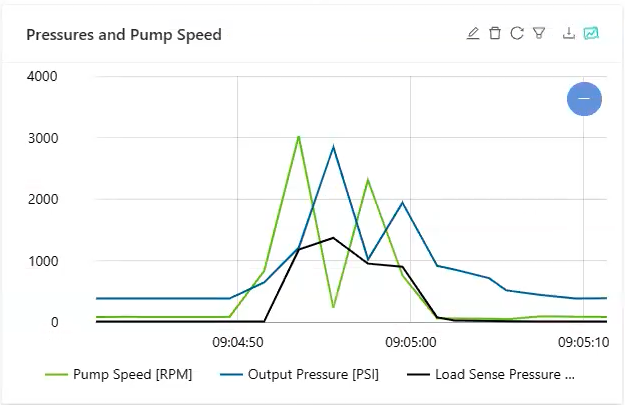Vocational Idling: What It Means and Why It’s a “Dirty Word”
If you haven’t had a chance to read our blog post on vocational idling, the term refers to the practice of leaving a work truck running while stationary—to power booms, buckets, air conditioning, etc. While idling an electric car may be close to harmless, heavy-duty vehicle idling isn’t; vocational trucks can idle more than 50% of the day, putting undue wear-and-tear on engines and other systems, reducing resale value, and increasing noise pollution and emissions.
Viatec’s SmartPTO and SmartPX systems are fully modular plug-and-play solutions that are compatible with any diesel- or gas-powered chassis and able to power your job site needs from a rechargeable battery source, drastically cutting vocational idling and all of the negative side effects that come with it.
Viatec’s Reporting Tool Gives You Insight and So Much More
While hybridizing with ePTOs is far more feasible than fully electrifying your work truck fleet, it’s still an investment. And, when investing in any upgrades, it’s important to be able to quantify their impact. With our reporting tool, you’re able to view detailed information on all of your units—like whether they’re charging or running; their operating hours by week, month, or year; fuel savings; and so much more. Through our client portal, you can view reports as charts, graphs, or spreadsheet data, and even export the information as a downloadable spreadsheet to share.
Reading The Report
Here are two example screenshots of the most critical stats from a client’s fleet for the month of April:

Individual truck data sorted into rows, summarized at the bottom for the overall fleet.

Data on idling hours eliminated, fuel saved, and CO2 avoided in April for the top-five performing trucks in the fleet.
Decoding the Reports: WHAT THOSE NUMBERS MEAN
1. Total Hours Idle Eliminated
This refers to the amount of time that our SmartPTO or SmartPX systems were operating, replacing the need for engine idling.
2. Total Hours Idle Eliminated in Range
3. Battery Used
Reports kilowatt hours of operation by our SmartPTO and SmartPX systems
4. Fuel Savings
This is a calculation of gallons of fuel that our systems saved each truck, based on the reported fuel economy of the vehicle and the number of idling hours eliminated.
5.CO2 Avoided
This calculation is based on market averages for CO2 production for the truck and the number of hours of idling eliminated.
What they’re actually telling us
As mentioned, vocational idling is dirty. And it doesn’t just harm the environment, it hits your bottom line, too. By hybridizing your fleet with our SmartPTO and SmartPX systems, you’re able to slash vocational idling, which in turn reduces wear-and-tear on your trucks; reduces noise on the job, creating a safer environment for workers and a more comfortable one for nearby residents; and saves fuel—in the above example, our client saved nearly 200 gallons of fuel in a single month for a fleet of just 10 work trucks. With the current cost of gas and diesel, those numbers add up fast.
The Reports In Action
While it’s validating to see your work truck fleet’s reduction in fuel usage, vocational idling, and CO2 emissions, these reports serve another practical purpose: remote monitoring and diagnostics. Our system provides reports on the temperature, pressures and pump speed of our SmartPTO and SmartPX systems in real-time, while operating. Here’s an example of a report on pressures and pump speed:

In this example, the graphs are nicely aligned—as pump speed increases, output pressure follows almost exactly and load sense pressure follows accordingly. This tells us that the system is operating correctly. If these graphs were not so well aligned, which is an early indicator that there may be an issue with your unit, you could take the necessary action to address the issue proactively. Viatec has service centers across the country, through our partnership with Terex, which can help solve any issue and get your work truck back on the job as quickly as possible.
Viatec’s Global Impact and Next Steps
You can see from these examples that using an ePTO like our SmartPTO or SmartPX helps our customers to cut idling time, which saves engine wear-and-tear, reduces noise pollution and emissions, and saves them money on truck upkeep and fuel costs. Reporting also helps our customers understand ePTO usage more than ever before, giving fleet managers operational visibility and a deeper understanding of how and where their trucks are being used, and how long their team is on the jobsite.
Our solutions are already helping utilities and businesses around the world to work smarter and meet their emissions goals. Maybe yours could be next?
Contact us today to start the conversation